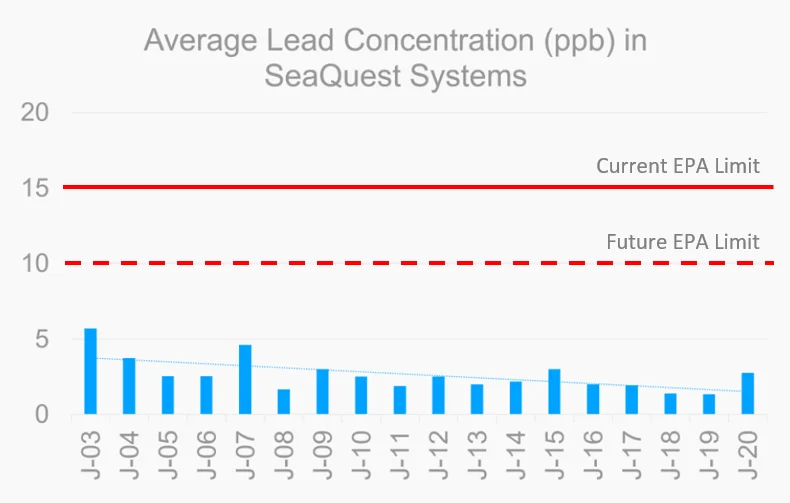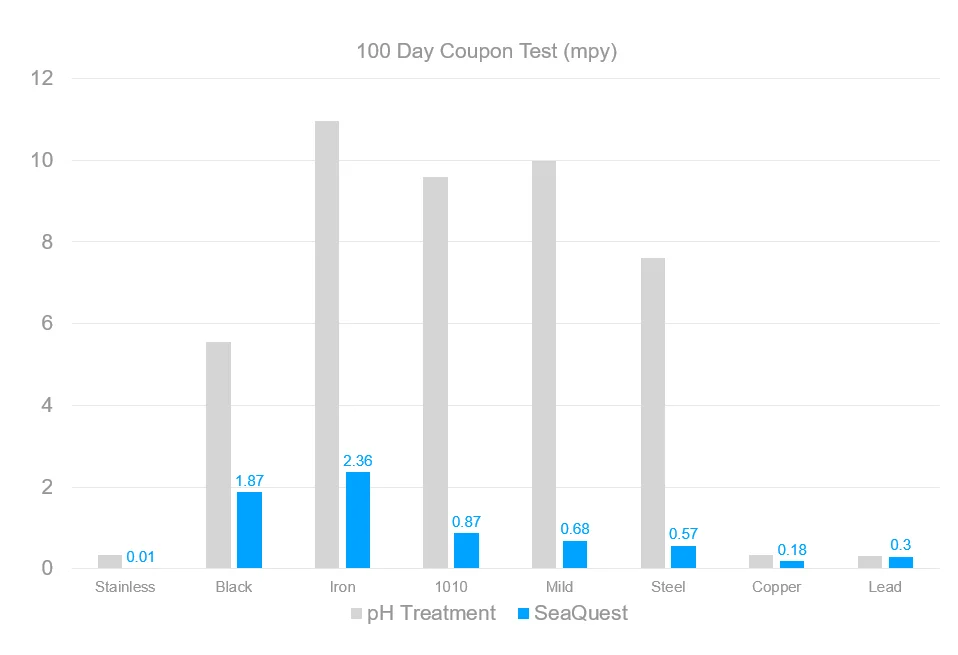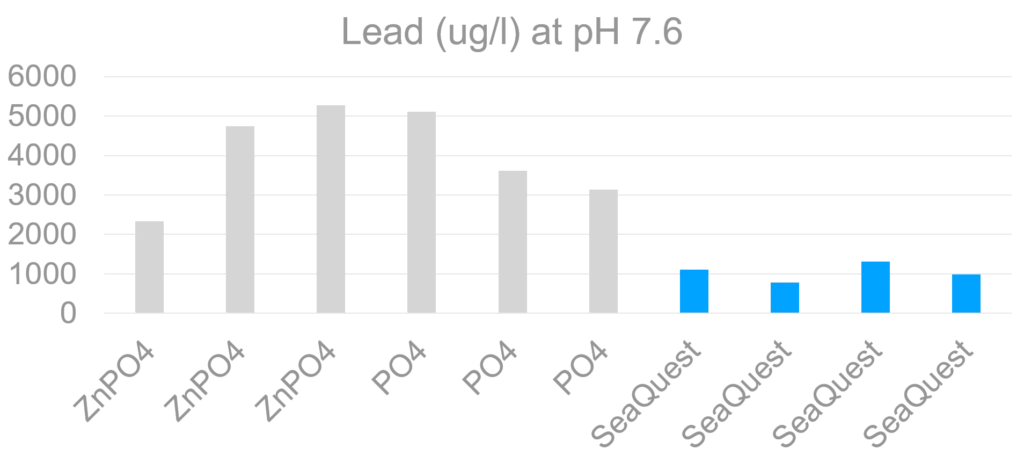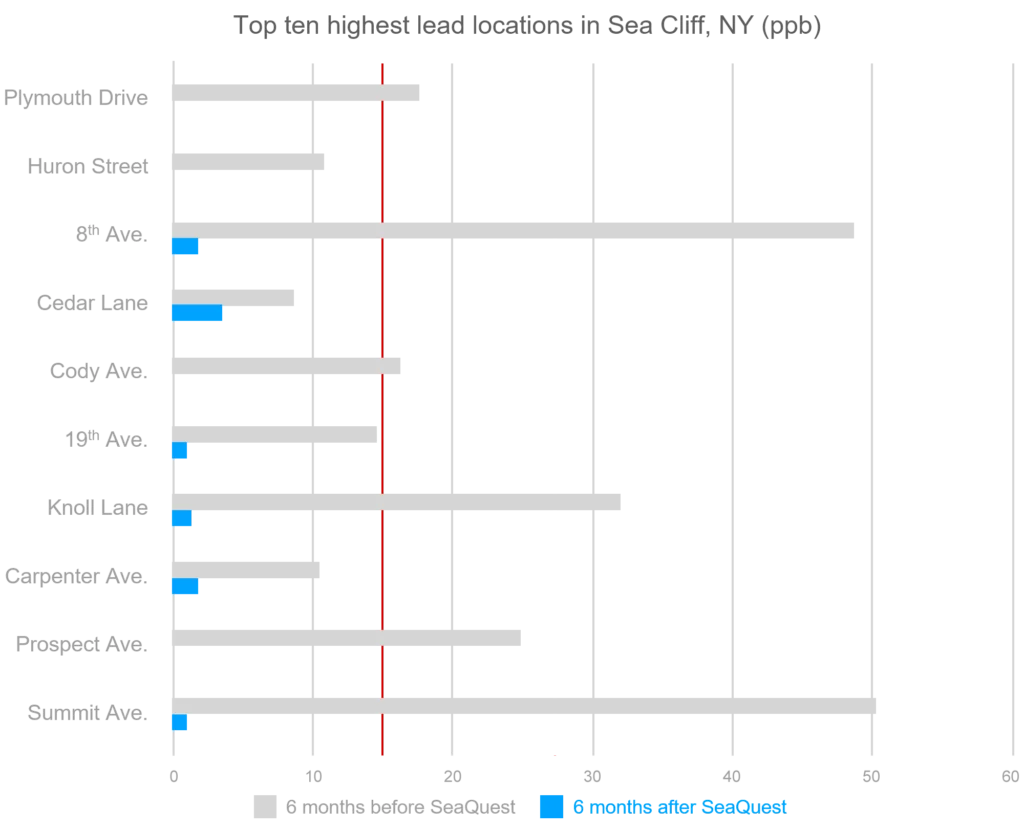SeaQuest controls lead without introducing other problems
without taking the pipes out of the ground.
SeaQuest is a proven method for controlling lead without creating complexity and unnecessary cost. It has been used extensively to solve water quality problems, including lead release, around the world for decades.
Under the new Lead and Copper Rule in 2024:
- Methods of monitoring will be more restrictive
- Penalties for non-compliance will be more restrictive
- Definition of compliance will be more restrictive
As a result, many systems are expected to be triggered into making CCT changes.
Using elevated pH or high levels of ortho-phosphate to attempt to control lead is expensive, complex, and can result in serious other complications for a water system.
For this reason, the upcoming Lead and Copper Rule stipulates that systems must consider a holistic approach to water quality and CCT choices.
Since SeaQuest does not rely on bulk water conditions (such as pH or temperature) it is the only method to control lead and address all other water quality issues.
Lead Results of SeaQuest in the US 2003-2020

39 systems were randomly selected from 300+ systems that have used SeaQuest in the United States since 2003.
During this time period:
- 9 were using SeaQuest continuously (time series chart) and remained in compliance even below the upcoming 10 ppb action level
- 30 began using SeaQuest (whisker plot) and reduced their average 90th percentile lead concentrations by 48%.

Example Corrosion Coupon Study
SeaQuest performs well in corrosion coupon studies.
In the proposed lead/copper rule, these studies can be used instead of a full pipe loop in certain areas to justify CCT changes.
Similar studies have been performed using SeaQuest across many systems to show improved corrosion control of all types of pipe metallurgy compared to existing treatment methods.
pH adjustment, zinc orthosphate, orthophosphate, blended phosphates, and silica have all been tested across multiple conditions.
SeaQuest continues to outperform these other treatment methods consistently.

17 Day Coupon Soak Test


SeaQuest performs well in soaked coupon tests, which are more aggressive than standard coupon tests.
In this test, the SeaQuest shows better control of lead leaching than orthophosphate and zinc phosphate.
Coupons were conditioned for 3 days then soaked for 14 days undisturbed. The average water conductivity was 49 umhos and average alkalinity was 15 ppm.
The doses range from 0.5-2.0 mg/l for the phosphate and 0.5-5.0 mg/l for the SeaQuest.
The SeaQuest outperforms all doses of both phosphates at both pH conditions, even at a low dose of 0.5 mg/l.
Lead Solder Pipe Loop Testing
This test shows the effect of SeaQuest vs orthophosphate at controlling lead release from lead solder, typically found in homes.
This type of test is more aggressive than coupon tests and takes significant investment to set up and perform.
SeaQuest loop 3 shows effectiveness at low dose and at natural pH.

| CONDITIONS | PROCEDURE |
|---|---|
| Loop 1 = 2 ppm Ortho, pH 7.2-7.4 | 2 Weeks conditioning at pH 7.2-7.4 |
| Loop 2 = 0.6 ppm SeaQuest, pH 7.2-7.4 | 30 Days treatment at baseline current conditions (2 ppm ortho, pH 7.2-7.4) |
| Loop 3 = 0.6 ppm SeaQuest, pH 7.2-7.4 | Lead analyzed during conditions for baseline to normalize data |
| Loop 4 = 0.6 ppm SeaQuest, pH 6.8 | Stagnant for 6- and 24-hour periods to simulate home use for 90 days ; 23 24hr samples, 6 6hr samples |
Harvested Lead Pipe Single Pass

A lead pipe previously treated with orthophosphate was harvested from the field and run through a single pass pipe loop.
- The first 7 weeks untreated water averaged 91 ppb
- The next 9 weeks SeaQuest treated water averaged 67 ppb
- The final 12 weeks SeaQuest treated water averaged 18 ppb
What this test shows is the effect SeaQuest can have in establishing control over a lead pipe, and that during the changeover from ortho-phosphate to SeaQuest there is not significant lead release.
Sea Cliff, NY
This system was out of control with Lead
Compliance issues resulted in NY DEP forcing a review and change to the CCT program
The top 10 worst lead locations were tracked before and after SeaQuest was used.
- 2 Locations had lead service lines which were not replaced
- Previously the system was treated with 1.1 ppm of polyphosphate and increasing pH.
- SeaQuest was dosed at 0.5 ppm
After changing to SeaQuest the 90th percentile lead results dropped from 14.7 ppb to 1.2 ppb. The top 10 worst locations all became under control.

